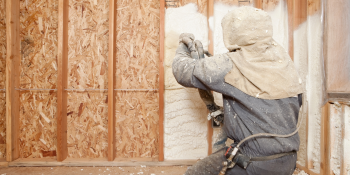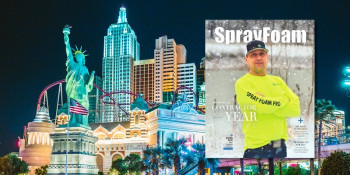Q&A Forums
Attic fire Post New Topic | Post Reply
| Author | Comments |
|---|---|
|
steven argus
Posted: Mar 16, 2010 01:29 PM
|
Attic fire
Hi Mason, We sprayed 10" of OC foam in an attic, backside of the sheetrock. The G.C. will later spray the ignition barrier paint(as per code)from a catwalk he built. As we were cleaning the celing below the attic, I noticed the ceiling in a certain area was warmer than the rest. In the attic, our 500 watt halogen light had fallen over, face down, on the foam. The light had burned the foam 8" down to within 2" of the ceiling and about a circle 10" in dia. We caught it in time, pulled out the burned foam, let everything cool down and resprayed it. We consider ourselves very lucky! My question to you: Why didn't the attic end up in a raging enferno? The foam was not sustaining the flame. Once the foam was burned it did not spread. Is the use of ignition barriers really needed in real world situations? Thank you. |
|
mason
Posted: Mar 16, 2010 02:59 PM
|
The scenario that you describe would not be likely to cause the exterior surface of the foam to flash. Higher sustained heat would typically be required to cause the foam to flash(such as that created by a cutting torch or welder). I would expect to see what you found, the light burning and charring the foam, which then loses its properties, and the weight of the light breaking down the charred foam and continuing to char the foam in a ring until it reaches the substrate. If it had reached the substrate, the wood would have caught on fire. So, yes you were fortunate to have caught it in time. |
|
Posted: Mar 16, 2010 08:14 PM
|
the heat was melting the plastic,,, it did not have a flame sourse to flash or burn,, subsequently it did not "burn" or "flash" (different phenom's) but it will melt/deform with sufficient heat... halogens are HOT,,,(put one down face first on some osb for an hour or so and see whats up) try the compact flourecents,,,they are more $$ but this aint lawncare..are u aware that if the GC dont ib coat the foam you are indeed in the liability loop?? him "saying he will,,him signin a document sayin he will" will not remove you from the letigation loop... |
|
steven argus
Posted: Mar 16, 2010 10:34 PM
|
My brand new $65.00 LED light is charging as I type. |
|
SprayFoamSupply.com
Posted: Mar 16, 2010 11:26 PM
|
Charging? Is it cordless? Will it run all day? Let me know how you like it. |
|
steven argus
Posted: Mar 17, 2010 01:27 PM
|
Thought about it over night. Inspected the foam remains today. The foam had not "melted". I now have "ash" just like I clean out of the fire place. The foam was burned. Torched up a sample with MAP gas today, (20" x 20" x 10" thick) the foam did burn through, but just like the lite, it did not burn the whole sample. It just burned where the flame was. Why didn't the foam sample flash? I can see a whole 2nd floor burning, then getting into an attic. Of course the whole attic will go up. But a torch? And when would a plumber with a torch ever be in an attic, above the foam, in unconditioned space, sweating water pipes? So sorry to stir this up again. George, Light will run for 4 hours, will light while charging. Not as bright as the halogen, but safer. I'll talk to ya when I place my next foam order. |
|
mason
Posted: Mar 17, 2010 02:02 PM
|
Yes, if the surface area is large enough the foam can flash. If the surface area is small it will not. Depending on the region, many things are in attics that a tradesperson might access and use a cutting torch. Furnaces, HVAC equipment, water pipes, etc. For example in my house in Savannah, there are 3 water heaters, 3 furnaces, dozens of pipes and miles of duct work. One of the furnaces was not working when we bought the house last month and a HVAC guy came in and used a torch to cut a copper pipe leading to it. |
|
mason
Posted: Mar 17, 2010 02:06 PM
|
As I said earlier, I would expect the foam to char not melt in the circumstances you describe, so ash would be what I would expect. |
|
steven argus
Posted: Mar 17, 2010 02:38 PM
|
Sorry mason, I was refering to fomedudes reply of "melting" So why should a vented attic (with foam on the attic floor), in the northeast, with no waterpipes, HVAC or any equipment at all, fall in the same catagory as an attic in the south with all kinds of equipment in it? And the only way the attic is going to be fully ingolfed in flames is when the space below it is totally on fire? Hopefully everybody is out by then, because of the 15 min thermal barrier (sheetrock ceiling)protecting the foam attic. |
|
mason
Posted: Mar 18, 2010 11:31 AM
|
It is harder for an attic floor to flash than the ceiling. I think many foams can pass the new attic and crawl space test if the foam is sprayed on the floor of the attic. Fire code experts and ICC staff give this reason for ignition barriers in attics and crawl spaces that have no equipment, pipes, etc. They assume if there is an attic hatch or crawl space hatch that there is a potential for someone coming in later and installing something that would require hotwork. |
|
steven argus
Posted: Mar 18, 2010 12:13 PM
|
Around here, there shouldn't be any hotwork in an uconditioned attic. Water pipes will freeze up there. Mabey if the home owner adds AC later on, there might be some copper line sets installed. But a homeowner is not going to let any one walk on and crush their 10" of OC foam that they just spent $10,000. on. We need "real world" tests. All of the "shade tree" tests we have performed prove that a torch is not enough to create a flash fire. Why doesn't the ICC pick on the cellulose guys that dump 12" of news paper in attics? |
|
mason
Posted: Mar 18, 2010 01:43 PM
|
Without trying to get the debate started again. The "shade tree" fire tests on foam plastic got the industry in hot water in the 60s and 70s. Mainly because if you take a small sample of foam plastic and put a torch to it, it either chars then goes out or it melts (thermoplastic). But in the real world, those same foam plastics were catching on fire and flashing. Different environments react differently. Large scale fire testing was conducted on hundreds of different types of foam and assemblies coordinated by the Society of the Plastics Industry with participation from all of the foam plastics groups including the sprayfoam industry. The resulting fire tests approved by the building codes evolved from this testing that was conducted in the 70s. I will be happy to send you some articles on the history of foam plastics fire tests with a lot more detail email me at masonknowles@aol.com |
|
steven argus
Posted: Mar 18, 2010 05:04 PM
|
Sorry Mason, I know I'm debating w/ you and I'm sure the last thing you want to do is argue with some redneck foamer like me. But, common sense goes along way in my book. So, if the ICC is saying you can't leave foam exposed in an attic because they are worried about the poor plumber stuck in an attic with burning foam, should't the test have: 1) a mocked up attic assem. and 2) a torch? The tests I've seen with the wood cribing built underneath the floor assem. then it is lit on fire, does that really represent Mr. plumber in the attic with his torch? As I see it, if a fire that big reaches the attic, the space underneath the attic is allready raging with fire, and everybody hopefully has gotten out. |
|
Posted: Mar 19, 2010 05:57 AM
|
(dont try logic or anecdotal thinkin,,aint gonna fly...the foam is EXPLOSIVE!!!,,,put the ring back in your nose and be lead like a good redneck) |
|
Rocks Rivers
Posted: Mar 19, 2010 06:40 AM
|
Guiness, I'm all with you on this issue. If it didn't flash over in your circumstances, then when will it? I see Mason's point about all foams being different, and he even mixed in the melting foam there in the last comment. Our foam doesn't melt and it is classified differently as such. The codes go a long way to spell out the difference between thermo set and thermo plastic foams ,and I think that's what Maosn is trying to explain - but I think Mason is confused because our foam doesn't melt and it's not an issue. Let's set it straight and get some real testing done. As far as red necks with guns, I'm a redneck and have a gun but that doesn't make me dangerous!Don't give in! We need blogs like this on here and elsewhere! |
|
mason
Posted: Mar 19, 2010 09:01 AM
|
I would like to send folks to the SPFA website for more info on the fire characteristics of burning foam. Check out their technical guideline AY 126, Thermal Barriers and Ignition Barriers. Also, the write up on the new attic and crawl space test. Talk to your suppliers about their foam and how it acts in a fire situation. Foam formulas are different even within the same company. They also react differently under various situations. But, a thermoset foam plastic like SPF can flash under certain circumstances. Major flash fires have been caused by cutting or welding torches used on SPF (even foams that were tested at Class 1 flame spread) and by installing closed cell foam too thick in attics. So, it is up to the contractor to obtain the correct data and testing information from their supplier and from the authority having jurisdiction in their area on the how to install the foam to be in compliance with the codes. Evaluation reports can assist in this effort. |
|
steven argus
Posted: Mar 19, 2010 11:58 AM
|
Jim must be on vacation. |
|
jimcoler
I have over 10 years of experience specifying and installing open and closed cell spray foam. I've sold my business but I'm still selling for the new owners and consulting on large and custom specific jobs. I've expanded my knowledge into t Posted: Mar 19, 2010 02:39 PM
|
Nope, I'm here, just waiting for the right time to chime in... and it's now! Mason, I don't know what drives you to tell people that foam can flash over when we have an example of when it didn't. It's obvious that in this case the fire was confined and secluded to a small portion of the attic. Lucky on the part of the contractor! But this doesn't help your case with regards to it flashing over! It hurts it! As far as the new testing by the SPFA and approved by the ICC-ES, it's false testing based on false data analysis. Number one, the tetsing is based on full room burn testing which is not realistic to attics or crawlspaces! When was the last time that you were in an attic or crawlspace with an 8' high flat ceiling?? The code says, "Tested in end use configuration". This is not end use configuration. The last time I tried to pass a "crawlspace" that was 8' high, the code official said, " No, that's a basement!" So, back to the point! Where the hazzard, or FIRE?? There was a fire in an attic and it didn't catch or ignite the rest of the foam. It just slowly burned down through the foam. So, I'm still opposed to the testing and data that was presented by the SPFA at the code hearing on this issue. Don't give up because the ICC in negligent in accepting it as is based on non "end use configuration" testing and false data! Jim Coler |
|
steven argus
Posted: Mar 19, 2010 10:55 PM
|
Why don't they regulate the plumbers with the torches? (regulate the sawzalls while their at it too) |
|
mason
Posted: Mar 20, 2010 09:59 AM
|
They do regulate hot work. OSHA has a large section on performing hot work. I researched this for the American Plastic Council and wrote a bulletin that is still in use by CPI today called 6 Steps to Fire Safety Using Polyiso and Polyurethane Foam. It is geared to the person performing hot work and follows the OSHA requirements. You can download a copy by going to sprayfoam.org or to polyurethane.org |
|
Rocks Rivers
Posted: Mar 21, 2010 07:26 AM
|
So, You mean to tell me that that they have a program already for hot work in an attic but you're still that much opposed to it? |
|
Scott Plantier
Posted: Jul 03, 2011 12:11 PM
|
Hi Mason, Would you please post the link you mention in this post: "Mason Moderator Posted: 3/19/2010 9:01 AM EST Reply RE: Attic fire I would like to send folks to the SPFA website for more info on the fire characteristics of burning foam. Check out their technical guideline AY 126, Thermal Barriers and Ignition Barriers. Also, the write up on the new attic and crawl space test." Thank you, Scott |
|
angus mcdougald
Posted: Jul 03, 2011 01:51 PM
|
I think they are concerned with a major fire and the smaller window of time for escape.... |





























